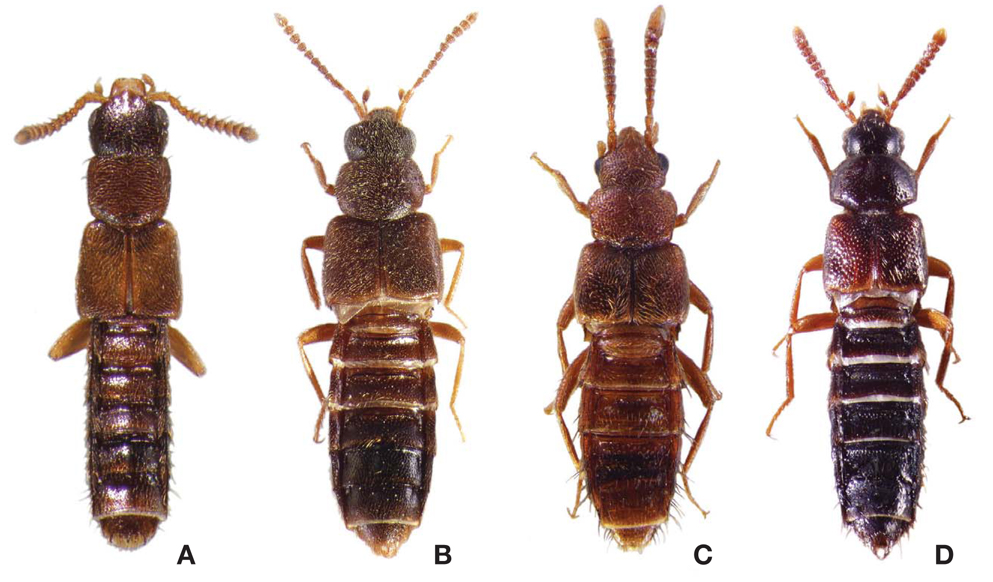



The tribe Homalotini Heer is one of the most species rich aleocharine tribes including more than 2300 described species in 152 genera worldwide (Newton and Thayer, 2005; Ashe, 2007). Members of Homalotini can be distinguished from other related tribes by the combination of the following characters: tarsal formula 4-4-5; mandible with patch or rows of denticles in ventral molar region; base of medial setae of prementum very close together, setal insertions in contact in many, setae displaced one behind the other in some; medial pseudopore field of prementum very narrow in many (Ashe, 1992, 2001).
During our studies of Korean Homalotini, we identified four species new to Korea. In this paper, we report four species,
For scanning electron microscopy (SEM), specimens were dissected in water by using fine insect pins. The dissected specimens were mounted on carbon tapes on slides, dried at 60℃ on a slide warmer for 24 h, and sputter-coated with Pt/Pd nanoparticles by using a sputter coater (Cressington 208 HR; Cressington Scientific Instruments Ltd., Watford, UK). Afterward, they were observed in a SEM (Hitachi S-4800; Hitachi High-Technologies Corporation, Tokyo, Japan). The terminology used here basically follows Sawada (1972) and Ashe (1984).
Order Coleoptera Linnaeus, 1758 Family Staphylinidae Latreille, 1802 Subfamily Aleocharinae Fleming, 1821 Tribe Homalotini Heer, 1839
1*Genus Anomognathus Solier, 1849Anomognathus Solier, 1849: 337.Type species: Anomognathus filiformis Solier, 1849.
1*Anomognathus armatus (Sharp, 1888) (Figs. 1A, 2A)Thectura armata Sharp, 1888: 294.Anomognathus armatus: Fenyes, 1914: 45; 1918: 85; Smetana, 2004: 447; Assing, 2011: 306.
Material examined. Korea: Chungnam Prov., Daejeon-si, Dong-gu, Secheon-dong, Mt. Sikjangsan, 36°19′11.34′′N, 127°29′59.7′′E, 170 m, 11 Apr 2010, Yoo IS, Lee SG, under bark (4 ex, 11♀ on slides); Gongju-si, Mt. Gyeryongsan, Dongwol, 36°19′39.0′′N, 127°15′46.7′′E, Ahn KJ, Choi SM, Park JS, ex FIT (2 ex); Jeonnam Prov., Hadong-gun, Hwagye-myeon, Ssanggyesa, 25 May 2000, Ahn KJ, under bark (13 ex).
Diagnosis. Body (Fig. 1A) length 1.7-2.1 mm. Body dorsoventrally strongly flattened, parallel-sided; reddish brown to dark brown, head and abdominal tergites VI-VIII dark brown.
Distribution. Korea (South), Japan, Taiwan.
2*Genus Heterota Mulsant and Rey, 1874 Heterota Mulsant and Rey, 1874: 194.Type species: Homalota plumbea Waterhouse, 1858.
3*Heterota onorum Maruyama, 2011 (Figs. 1B, 2B)Heterota onorum Maruyama, 2011: 98.
Material examined. Korea: Jeonnam Prov., Yeosu-si, Samsan- myeon, Geomun-ri, Isl. Geomundo, 34°01′31.4′′N, 127°18′48.8′′E, 7 m, 2 Jul 2011, Yoo IS, under decaying seaweeds on seashore (15 ex, 2♂♂1♀ on slide); Jeju Prov., Jeju-si, Oedoi-dong, 33°29′48.2′′N, 126°26′29.0′′E, 3 m, 9 Sep 2010, Kim TK, Yoo IS, under decaying seaweeds on pebble beach (6 ex, 1♂1♀ on slides).
Diagnosis. Body (Fig. 1B) length 2.6-2.9 mm. Body robust, subparallel-sided; brown to reddish brown, head and abdominal tergites VI-VII dark brown.
Distribution. Korea (South), Japan.
Remarks. This coastal species is similar to
1*Genus Neosilusa Cameron, 1920Neosilusa Cameron, 1920: 232.Type species: Stenusa ceylonica Kraatz, 1857.
2*Neosilusa ceylonica (Kraatz) (Figs. 1C, 2C)Stenusa ceylonica Kraatz, 1857: 8. Pronomaea subrufa Motschulsky, 1861: 149. Silusa crassicornis Sharp, 1888: 374. Silusa (Stenusa) ceylonica : Fenyes, 1914: 46. Silusa (Plagiusa) ceylonica : Fenyes, 1918: 82. Neosilusa ceylonica : Cameron, 1920: 233; Pace, 1984: 15;1993: 71; 1998: 142; Smetana, 2004: 450. Plagiusa ceylonica: Cameron, 1939: 167.
Material examined. Korea: Jeonnam Prov., Sinan-gun, Heu-ksan-myeon, Hongdo-ri, Yangsanbong, Isl. Hongdo, 34°40′ 45.2′′N, 125°11′32.6′′E, 22 Aug 2006, Min HK coll., ex sifting (22♂♂♀♀, 2♂♂ on slides); Sinan-gun, Heuksanmyeon, Sosa-ri, Isl. Heuksando, 34°39′34.9′′N, 125°25′03.8′′E, 23 Aug 2006, Min HK coll., ex sifting (1 ex); Jeonbuk Prov., Jeongeup-si, Gamgok-myeon, Ogongjae (pond), 22 Jul-5 Aug 2004, col. Cho YB, bamboo forest by FIT (3 ex); Gyengnam Prov., Jingu-si, Gajoa-dong, Gyeongsang Univ., 29 Aug 2003, Lim CS, ex bait (7 ex); Chungnam Prov., Daejeon-si, Chungnam National Univ., 20 May 2002, Park JS, Choi JH, ex sifting (2 ex); Kongju-si, Kyerong-myeon, Jungjang-ri, Kyerongsan, Kapsa, 12 Aug 2000, Kim MH, ex mushroom (1 ex).
Diagnosis. Body (Fig. 1C) length 1.8-2.4 mm. Body slightly robust and rugose; surface punctuate; reddish brown, antennomeres 4-10 brown, abdomen strongly glossy, posteriorhalf of abdominal tergite V and tergite VI dark brown.
Distribution. Korea (South), China (Beijing, Guandong, Guizhou, Henan, Hongkong, Jiangsu, Sichuan, Yunnan, Zhejiang), Japan, Taiwan, India (Himachal Pradesh, Uttaranchal, Uttar Pradesh), Afrotropical, Australian Region.
Remarks.
1*Genus Silusa Erichson, 1837Silusa Erichson, 1837: 377. Type species: Silusa rubiginosa Erichson, 1837.
2*Silusa (Silusa) lanuginosa Sharp, 1888 (Figs. 1D, 2D)Silusa lanuginosa Sharp, 1888: 375. Silusa (Silusa) lanuginosa: Smetana, 2004: 450.
Material examined. Korea: Chungbuk Prov., Yeongdong-gun, Sangcheon-myeon, Mulhan-ri, Mt. Minjujisan, 36°03′35.22′′N, 127°52′31.26′′E, 518 m, 10 Apr 2011, Kim YH, Kim YG, decaying persimmons (25 ex, 1♂1♀ on slides).
Diagnosis. Body (Fig. 1D) length about 3.4 mm. Body slightly robust, parallel-sided, glossy; surface punctuate; reddish brown to brown, head and abdomen dark brown.
Distribution. Korea (South), China (Jilin), Japan.
Remarks. This species was collected from decaying persimmons at early spring in Korea.

